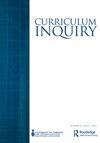Reckoning with white supremacy and anti-Black racism in the Virginia US history standards
IF 1.6
3区 教育学
Q2 EDUCATION & EDUCATIONAL RESEARCH
引用次数: 1
Abstract
Abstract This study is an ethnographic content analysis of the Virginia US History Standards of Learning, grades 4–12. We used Yosso’s (2002) framework of a critical race curriculum (CRC) to better understand how white supremacy and anti-Black racism are portrayed in the standards. Results indicate that racialized representation is highly skewed in favour of white men, who comprise 70% of the individuals in the curriculum. White people are mostly portrayed as individuals and almost never as a racialized group, whereas Black people are mostly portrayed as a monolithic group and less often as individuals. Our close reading of the standards identified several tactics that promote white supremacy, including: avoiding accountability, playing the victim, and Confederate lost cause propaganda. We also identified tactics that sustain anti-Black racism, including: Black messiahs, illusions of inclusion, and silos of Black victimhood. There are many units that portray Black people as the victims of anti-Black racism, but white people and their social institutions are never portrayed as the creators, enforcers, or beneficiaries of a racist society. This reckoning is a step towards new standards that are centred on social justice, diverse perspectives, and full humanity for all groups.弗吉尼亚州美国历史标准中的白人至上主义和反黑人种族主义
摘要本研究是对美国弗吉尼亚州4-12年级历史学习标准的民族志内容分析。我们使用Yosso(2002)的批判性种族课程(CRC)框架来更好地理解标准中白人至上主义和反黑人种族主义的描述。结果表明,种族化的代表性高度偏向白人男性,他们占课程中70%的个人。白人大多被描绘成个人,几乎从来没有被描绘成种族化的群体,而黑人大多被描绘为一个单一的群体,很少被描绘成个体。我们仔细阅读了这些标准,发现了一些宣扬白人至上主义的策略,包括:逃避责任、扮演受害者和邦联失败的宣传。我们还确定了维持反黑人种族主义的策略,包括:黑人救世主、包容的幻想和黑人受害者的筒仓。有许多单位将黑人描绘成反黑人种族主义的受害者,但白人及其社会机构从未被描绘成种族主义社会的创造者、执行者或受益者。这一清算是朝着以社会正义、不同观点和所有群体的全人类为中心的新标准迈出的一步。
本文章由计算机程序翻译,如有差异,请以英文原文为准。
求助全文
约1分钟内获得全文
求助全文
来源期刊

Curriculum Inquiry
EDUCATION & EDUCATIONAL RESEARCH-
CiteScore
3.10
自引率
17.60%
发文量
37
期刊介绍:
Curriculum Inquiry is dedicated to the study of educational research, development, evaluation, and theory. This leading international journal brings together influential academics and researchers from a variety of disciplines around the world to provide expert commentary and lively debate. Articles explore important ideas, issues, trends, and problems in education, and each issue also includes provocative and critically analytical editorials covering topics such as curriculum development, educational policy, and teacher education.
 求助内容:
求助内容: 应助结果提醒方式:
应助结果提醒方式:


